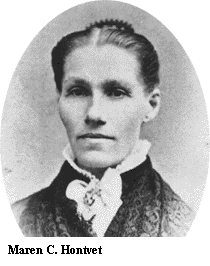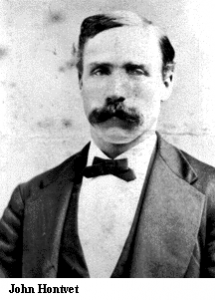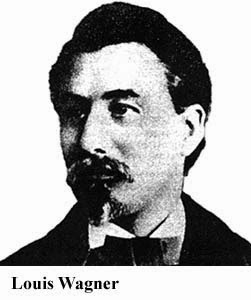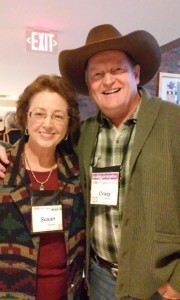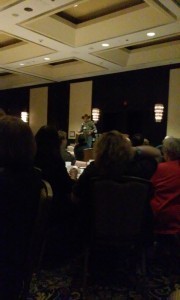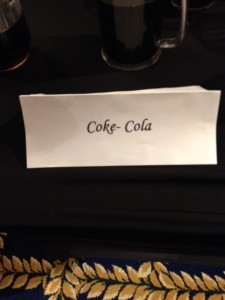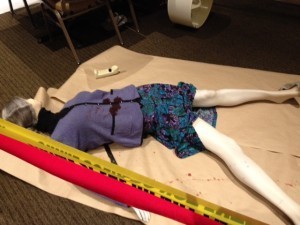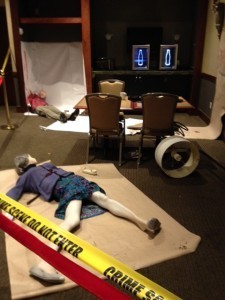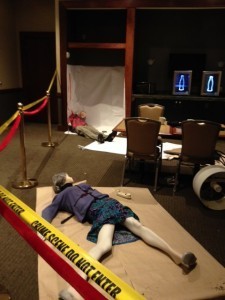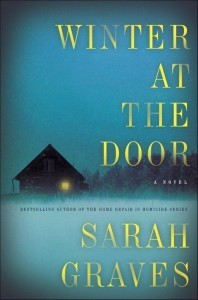Lea Wait's Blog, page 306
November 11, 2014
Best New England Crime Stories 2015: Rogue Wave–the Maine Connections
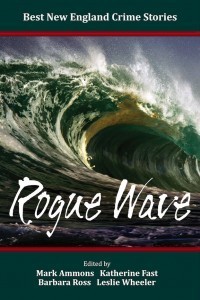 Hi, Maine Crime Writers Blog readers. Barb here. Last weekend was the New England Crime Bake and with it comes the launch of the latest Level Best Books anthology of crime stories by New England authors.
Hi, Maine Crime Writers Blog readers. Barb here. Last weekend was the New England Crime Bake and with it comes the launch of the latest Level Best Books anthology of crime stories by New England authors.
The latest entry in the series is Best New England Crime Stories 2015: Rogue Wave. You can buy it from Level Best here, or from Amazon (paperback or Kindle) here, or order it from your favorite independent bookstore.
As we have here on the blog for the last five years, we’re looking at the Maine connections. As always there are some familiar faces and some exciting new voices. I will say that when all the submissions are counted, Maine acquits itself very well. Only Massachusetts, with 5 times the population, sends in more stories. So from amongst that crowded field, here are the Maine authors included.
 Vicki Doudera: One of the familiar faces is MCW’s own Vicki Doudera. Vicki is the author of the Darby Farr Mysteries (Midnight Ink) featuring a crime-solving, deal-making real estate agent. The latest (and fifth) is Deal Killer. A top-producing realtor in Camden, Maine, Vicki wrote the best-selling guide, Moving to Maine: The Essential Guide to Get You There and What You Need to Know to Stay, and is researching Death on Katahdin, a non-fiction account of fatal mishaps on Maine’s tallest mountain. “Bebe Bamboozles the Missus,” her story in Rogue Wave, features a modern day domestic servant who must figure out how to handle a difficult mistress following the sudden demise of the master.
Vicki Doudera: One of the familiar faces is MCW’s own Vicki Doudera. Vicki is the author of the Darby Farr Mysteries (Midnight Ink) featuring a crime-solving, deal-making real estate agent. The latest (and fifth) is Deal Killer. A top-producing realtor in Camden, Maine, Vicki wrote the best-selling guide, Moving to Maine: The Essential Guide to Get You There and What You Need to Know to Stay, and is researching Death on Katahdin, a non-fiction account of fatal mishaps on Maine’s tallest mountain. “Bebe Bamboozles the Missus,” her story in Rogue Wave, features a modern day domestic servant who must figure out how to handle a difficult mistress following the sudden demise of the master.
 Kathy Lynn Emerson: As readers of this blog know, Kathy Lynn is the author of the Face Down series, set in sixteenth century England, the Diana Spaulding 1888 Quartet, the Liss MacCrimmon series (w/a Kaitlyn Dunnett), the forthcoming Mistress Jaffrey Mysteries, and How to Write Killer Historical Mysteries, winner of the Agatha Award for non-fiction. Her story in Rogue Wave, “The Blessing Witch” takes place in sixteen century England and is about a woman who may or may not be a witch, but who solves a mysterious death using other abilities.
Kathy Lynn Emerson: As readers of this blog know, Kathy Lynn is the author of the Face Down series, set in sixteenth century England, the Diana Spaulding 1888 Quartet, the Liss MacCrimmon series (w/a Kaitlyn Dunnett), the forthcoming Mistress Jaffrey Mysteries, and How to Write Killer Historical Mysteries, winner of the Agatha Award for non-fiction. Her story in Rogue Wave, “The Blessing Witch” takes place in sixteen century England and is about a woman who may or may not be a witch, but who solves a mysterious death using other abilities.
 Judith Green: Readers of the Level Best series will know Judy Green. I believe she is the only person to have a story in all twelve anthologies. As a former Adult Education Director for an eleven town school district in western rural Maine, Judy has written twenty-five high-interest/low-level books for adult readers. “A Good, Safe Place” published in the 2010 Level Best anthology Thin Ice, was nominated for an Edgar® Award. Judy’s story in Rogue Wave, “The First Thing That Comes Back,” gives us another chapter in the long and interesting life of Margery Easton, wife and mother in rural Maine. (Note from Barb: I am still waiting for a major publisher to collect these. They are that good.)
Judith Green: Readers of the Level Best series will know Judy Green. I believe she is the only person to have a story in all twelve anthologies. As a former Adult Education Director for an eleven town school district in western rural Maine, Judy has written twenty-five high-interest/low-level books for adult readers. “A Good, Safe Place” published in the 2010 Level Best anthology Thin Ice, was nominated for an Edgar® Award. Judy’s story in Rogue Wave, “The First Thing That Comes Back,” gives us another chapter in the long and interesting life of Margery Easton, wife and mother in rural Maine. (Note from Barb: I am still waiting for a major publisher to collect these. They are that good.)
 Maurissa Guibord: Maurissa Guibord is new to Level Best. She lives on the beautiful coast of Maine. She is the author of two fantasy books for young adults (Warped, 2011 and Revel, 2013, Delacorte) as well as numerous stories for both adults and children. She has been a finalist for both the Rita award as well as the Agatha Award. In her story, “Stroke of Genius,” an artist creates a novel mode of expression.
Maurissa Guibord: Maurissa Guibord is new to Level Best. She lives on the beautiful coast of Maine. She is the author of two fantasy books for young adults (Warped, 2011 and Revel, 2013, Delacorte) as well as numerous stories for both adults and children. She has been a finalist for both the Rita award as well as the Agatha Award. In her story, “Stroke of Genius,” an artist creates a novel mode of expression.
 Dale T. Phillips: Dale Phillips studied writing with Stephen King at the University of Maine, and has published over thirty short stories and four novels, three in the Zack Taylor series. He’s appeared on stage, television and in an independent feature film. He competed on two nationally televised quiz shows, Jeopardy and Think Twice, and lost spectacularly both times. His story in Rogue Wave, “Automat” tells us what happened before, during and after the moment evoked in Edward Hopper’s iconic painting of the same name.
Dale T. Phillips: Dale Phillips studied writing with Stephen King at the University of Maine, and has published over thirty short stories and four novels, three in the Zack Taylor series. He’s appeared on stage, television and in an independent feature film. He competed on two nationally televised quiz shows, Jeopardy and Think Twice, and lost spectacularly both times. His story in Rogue Wave, “Automat” tells us what happened before, during and after the moment evoked in Edward Hopper’s iconic painting of the same name.
 Karla M. Whitney: Karla Whitney’s publications include textbooks, non-fiction articles and illustrations. Her second mystery novel and a slew of single-paned comics are in the works. She’s a member of SinC, MWA and the Portland Museum of Art. In her first published fiction story, “More to the Point,” a tormented neighbor sets her sights on revenge.
Karla M. Whitney: Karla Whitney’s publications include textbooks, non-fiction articles and illustrations. Her second mystery novel and a slew of single-paned comics are in the works. She’s a member of SinC, MWA and the Portland Museum of Art. In her first published fiction story, “More to the Point,” a tormented neighbor sets her sights on revenge.
 Gregory William Allen: Gregory William Allen/Bill Carito is a lifelong resident of Greater Boston who became a Red Sox fan in 1961, the year after Ted Williams retired. Before he started writing, Bill Carito spent his professional life working in politics, consulting on campaigns, lobbying, and operating a political technology company. He’s a graduate of the University of Pennsylvania and lives in Somerville and Boothbay Harbor, Maine with his wife. They are the proud parents of Kate Carito, and her brother Rob.
Gregory William Allen: Gregory William Allen/Bill Carito is a lifelong resident of Greater Boston who became a Red Sox fan in 1961, the year after Ted Williams retired. Before he started writing, Bill Carito spent his professional life working in politics, consulting on campaigns, lobbying, and operating a political technology company. He’s a graduate of the University of Pennsylvania and lives in Somerville and Boothbay Harbor, Maine with his wife. They are the proud parents of Kate Carito, and her brother Rob.
If all that sounds a little familiar, it is because Bill is my husband. He submitted his story, “Ted Williams’ Dreams” anonymously and didn’t reveal his identity until after his story was chosen. Though after reading the story and hearing the reveal, my fellow editors response was, “Aren’t you afraid to sleep with that guy?” I found the story delightfully creepy.
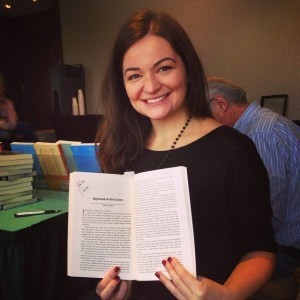 Kate Carito: And we’re keeping it all in the family, because Rogue Wave also marks my daughter’s first publication. Kate is an MFA candidate in fiction at the University of Massachusetts Boston. She is the former Editor of the Breakwater Review and Assistant Editor at Novella-T. In 2012, she received an MA with Distinction in Creative Writing from London Metropolitan University. Prior to her studies, she worked at O, The Oprah Magazine. In her story “Baptized at the Casino,” a thirty-something slacker and her wheelchair-bound grandmother attempt to rob a casino, until it all goes hilariously awry.
Kate Carito: And we’re keeping it all in the family, because Rogue Wave also marks my daughter’s first publication. Kate is an MFA candidate in fiction at the University of Massachusetts Boston. She is the former Editor of the Breakwater Review and Assistant Editor at Novella-T. In 2012, she received an MA with Distinction in Creative Writing from London Metropolitan University. Prior to her studies, she worked at O, The Oprah Magazine. In her story “Baptized at the Casino,” a thirty-something slacker and her wheelchair-bound grandmother attempt to rob a casino, until it all goes hilariously awry.
I hope you enjoy these stories–and all the other stories in Best New England Crime Stories 2015: Rogue Wave–as much as I did.
November 10, 2014
Fifteen Things You Probably Don’t Know About Me
Lea Wait, here, taking deep breaths after two weeks on the road … and more than two weeks of major computer problems that resulted in my not being on line and therefore not receiving (or answering) emails. (Who has telephone numbers for people? not me!) Since I missed all that sharing time on emails and social media, today I decided to come clean, and share some things most people (maybe you?) don’t know about me.
No explanations, by the way … just the facts!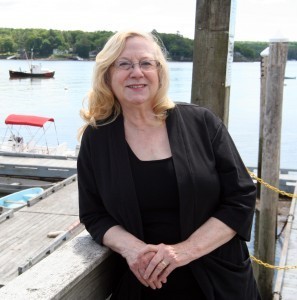
1. I don’t have a cellphone. Neither does my husband.
2. I’ve never been a heavy drinker … but I do have a DWI conviction (shudder) in my distant past. My favorite cocktail is a sidecar … and I love fine champagne.
3. Sometimes I volunteer to go to the grocery just so I can buy (and devour) a chocolate bar. My husband once said he’d never seen me buy one. (Secret splurge kept secret.)
4. The house I live in was built in 1774. In 1832 it was moved from an island to the mainland. I’ve never seen a ghost there, but sometimes a television set in an empty room turns itself on. Often to a French channel.
5. I come from a female family: I’m the oldest of two sisters. Between the three of us we have seven daughters; no sons. Grandchildren? I have eight; five are girls. On the other hand, my husband is the oldest of four brothers. Together they produced four boys and one girl.
6. My youngest daughter has now been engaged for 12 years. She and her guy seem happy, although I doubt she can fit into the wedding dress I bought her in 2003.
7. First when I was in college, and later, in New York City, I did improvisational theater.
8. When I was twenty-five I married a television comedy writer who worked for Johnny Carson and Dick Cavett, among others. He also invented Rodney Dangerfield’s “I don’t get no respect” line.
8. Bob, the wonderful man I’m married to today, took the pictures at that wedding.
9. I was thirty years old and single when my first daughter came home. She’d been born when I was 25.
10. The books that most influenced my life were Louisa May Alcott’s Little Women and Little Men. I read both books dozens of times, and, without realizing it, I patterned my family after Jo March’s.
11. I love the smells of freshly mown grass and burning leaves and mud flats.
12. I have (full) floor to ceiling bookcases (note the plural) in every room of my home (except the bathroom.) And I still have about a dozen cartons of books I have no space for. One room is just for mysteries.
13. I once smuggled drugs into India. (In case someone reading this is with the DEA … the drugs were legal in this country, but importing them to India was forbidden. They were for several orphanages.)
14. For three (long) years my business card read “Engineering Manager – AT&T.”
15. My daughters and I once appeared on Good Morning, America.
And I love Christmas and hot chocolate. What more is there to know?
November 9, 2014
Terror On Smuttynose Island
Smuttynose Island
VAUGHN HARDACKER here. Once again I am returning to the realm of true crime. The Islands of the Shoals lie six miles off the coast of Portsmouth, New Hampshire and many people believe that they are in New Hampshire, However, the island group consists of nine islands, five are in Maine and four in New Hampshire, and were named by English explorer Capt. John Smith after sighting them in 1614. The first recorded landfall of an Englishman was that of explorer Capt. Christopher Levett, whose 300 fishermen in six ships discovered that the Isles of Shoals were largely abandoned in 1623.
Smuttynose Island, at 25 acres, is the third-largest island. It is known as the site of Blackbeard’s honeymoon, later for the shipwreck of the Spanish ship Sagunto in 1813, and then for the notorious 1873 murders of two young women. The latter is recalled in the story, “A Memorable Murder”, by Celia Thaxter, in the 1997 novel, The Weight of Water, by Anita Shreve (and in the film of the same name), and in the song, “The Ballad of Louis Wagner” by John Perrault.
The terrifying events outlined by Thaxter and Shreve took place in the early morning hours of March 6, 1873. The island was inhabited by a single couple, John Honvet and his wife Maren, who arrived there from Norway in 1868. John was a commercial fisherman and he would sail his schooner, the Clara Bella, to the fishing grounds, draw his trawl lines, and then set sail for home in late afternoon. His industriousness earned him respect from his friends and neighbors on other islands (whose population rarely surpassed fifty).
Louis Wagner was working solo, barely eking out a living fishing the waters off the Isles of Shoals when he met Honvet. For two years John and Maren took Wagner, a dark muscular Prussian with a thick accent, under their care, seeing that he was never in need of food or clothing and even went so far as to include him in John’s prosperous business. During the two plus years they were acquainted it is said that Wagner and the Hontvets became as close as brothers and sister.
Though content with their new lives, the Hontvets missed their families in Norway. Maren cherished her small cottage, but often her only companion during John’s absences while fishing was her small dog, Ringe. In May 1871, Maren’s sister, Karen Christensen, arrived from Norway and within a few weeks obtained a position as a live-in maid with a family on nearby Appledore Island (the largest of the Isle of The Shoals islands).
By June of 1872, John’s business had prospered to the point where he was able to hire Wagner, giving him a room within his home. However, in October of that year John found himself with more help than he needed. His brother, Matthew arrived from Norway with Maren’s brother, Ivan Christensen and his wife Anethe. All five family members lived together in the Hontven cottage and Ivan and Matthew went to work with John.
Wagner stayed on for five weeks after Ivan, Matthew, and Anethe arrived and then booked passage as a hand on the Addison Gilbert, a fishing schooner, in November. His luck took a turn for the worse. The Addison Gilbert was wrecked and he found himself reduced to working along the docks in Portsmouth, New Hampshire. He barely made enough money to pay his board. By March of 1873 he was destitute, his shoes and clothes were worn and tattered, and he was behind in his rent.
John, Ivan, and Matthew had set sail early on the morning of March 5, 1873. They placed their trawl lines, intending to sell the catch in Portsmouth and buy bait there, they met a neighbor and asked him to stop by Smuttynose and inform the women that due to a change in the wind direction they would be sailing directly to the mainland.
The women, Maren, Anethe, and Karen (she had left her position on Appledore and taken one as a seamstress in Boston) who was visiting, got the word in the late afternoon.
When the Clara Bella docked in Portsmouth in early evening, Louis Wagner was on hand to help tie the vessel down. He inquired if John and his crew would be returning to Smuttynose that evening. He learned that it depended upon whether or not the bait they wanted to buy was delivered on time. If it was they would return, if not they would stay in port and return home in the morning.
Wagner was last seen in Portsmouth at 7:30 that evening. He learned that the bait had not arrived and decided to burglarize the Hontvet’s home. He stole a dory and rowed into the harbor and out to sea. The feat of rowing twelve miles to the Isles of Shoals and back was difficult, but not impossible and Wagner was a skilled oarsman, driven by desperation.
The three woman had waited for the men and by 10 PM decided not to do so any longer. They changed into their night clothes and made a bed for Karen in the kitchen, where it was warmer. Maren and Anethe retired to an adjoining bedroom.
Rather than go ashore in the cove where John kept the Clara Bella, Wagner rowed to the far side of the island and disembarked on the rocky shore. He observed the cottage for several hours after the inside lights had gone out. Confident that the women were asleep he made his move. He quickly found the kitchen door unlocked and stepped inside. He jammed a piece of wood into the latch of the bedroom door. His movement aroused the dog and it barked, waking Karen. She asked, “John, is that you?”
Maren then awoke and called to her sister, “Karen? Is something wrong?”
“John scared me!” With that Wagner reached for a chair and struck a incapacitating blow. Karen screamed as he continued his assault.
Karen struggled to her feet and tugged at the bedroom door. Battered and bleeding, she freed the latch and fell at Maren’s feet. Wagner rushed again, now swinging at and hitting both women. Maren managed to pull Karen out of his reach and closed and barricaded the door.
Anethe watched the attack from a corner of the room. Maren implored her to run and hide. Anethe climbed out the bedroom window and stood barefoot in the snow, frozen with fright.
Wagner gave up his assault on the locked door and left the house. In the light of the quarter moon, Maren could see who their attack was. He closed with Anethe and grabbed an axe from its place on the woodpile and with a single motion drove the blade into Anethe’s head. Her lifeless body fell as he continued to strike her. During this horrific attack, Maren was so close that she could have reached through the window and touched him.
Realizing that she could do nothing to help Anethe, Maren turned her attention to saving her sister and herself. She begged Karen to run. Karen, however, was on the verge of fainting and was unable to do anything. By this time Wagner had returned to the house with the axe. Believing both she and her sister would be killed if she remained, Maren wrapped herself in a heavy skirt and, when she heard Wagner return to the house, climbed through the window and ran. She headed for the cove hoping to find Wagner’s boat there. When she did not see it, she ran along the shore to the far side of the island. As she passed the cottage she heard Karen shout in agony. She crawled between two rocks near the water’s edge where the surf obliterated all other sound.
Karen tried to escape through the window but was so weak that it was too much. Wagner finally broke into the room and swung the axe, missing her and hitting the sill, which broke the axe handle. He then twisted a handkerchief around her neck and strangled her until she was dead.
Bloody footprints showed his search for Maren and where he dragged Anethe by her feet into the kitchen. He was exhausted and brewed a pot of tea, leaving blood on the handle, and ate food he had brought using a plate, knife and fork from the Hontvet’s kitchen. He ransacked the house, finding only fifteen dollars and departed, leaving Anethe’s body on the floor beside a clock he had knocked off the mantle—its hands were stopped at seven minutes past one.
It was after eight in the morning when Maren got the attention of the children of Jorge Ingerbredsen, who were playing beside their home on Appledore Island. Jorge rowed across the quarter mile of sea to rescue her. He returned her to his home and with several other men they returned to Smuttynose.
Finding no one on Smuttynose, the men returned home and searched there. A few hours later the Clara Bella was sighted on the horizon and they signaled her. Matthew and Ivan rowed a skiff to Appledore and John sailed the schooner to her moor on Smuttynose. When the men found Maren at the Ingerbredsen house and heard the horrific tale they rushed to Smuttynose, arriving the same time as John. They found the bodies and searched the full contents of their destroyed home, before sailing the schooner to Appledore. That afternoon, John and others carried Maren’s tale of terror to the authorities in Portsmouth.
The stolen dory was found in Newcastle, where two men who knew Wagner reported they had seen him about six o’clock on the morning of March 7, near a place called the Devil’s Den. Wagner had returned to his boarding house, changed some of his clothes and took a 9 AM train to Boston. Wagner was arrested that evening at a boarding house where he had stopped to see some women that he knew. He offered no resistance.
The following day he was transferred from Boston (where a jeering crowd followed—the crime had been widely reported throughout the east coast) to Portsmouth (where a crowd of 10,000 narrowly missed tearing him apart).
Smuttynose falls under the jurisdiction of Maine so Wagner had to be tried there. Three days after arriving in Portsmouth, he was moved from the jail to the train where a lynch mob of over 200 fishermen were waiting. The police escort drew their revolvers and a company of bayonet-wielding Marines were called from the Navy base, but the mob was not easily subdued. The escort was showered with stones and bricks.
Louis Wagner’s trial began in Alfred, Maine on June 9, 1873. It took nine days of testimony and 55 minutes of deliberation for the jury to find him guilty as charged. He broke out of jail within a week, but was recaptured in New Hampshire. On June 25, 1875, 27 months after the crime, Wagner was led into the yard of the state prison in Thomaston, Maine, and hanged. Wagner maintained his innocence to the very end.
Maren and John Hontvet were never to live in the Isles of Shoals again. They moved to Portsmouth, where John continued working as a fisherman. There are two small houses on the island. One of them, the Samuel Haley house, was once believed to be the oldest structure in the state of Maine. Smuttynose is not populated today.
November 8, 2014
Our Coverage of the Crime Bake continues…
Another fun day at the Crime Bake with an opening panel exploring the many faces of the mystery genre, including a room full of crime writers line dancing at the cowboy banquet:

Jonathan Shapiro, dressed as an old west hanging judge, and the Hon. Michael Ponsor, author of The Hanging Judge
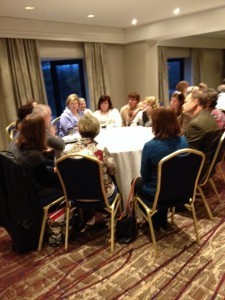
Detectives answer questions at the Ask the Experts round table session
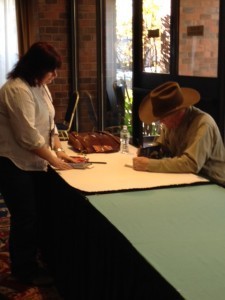
Craig Johnson signing a book for a fan

True crime panel with Margaret McLean, author of Whitey on Trial, PI John DiNatale, author of The Family Business, Deborah Halber, author of The Skeleton Crew, Eric Rickstadt, author of The Silent Girls, and Michael Blanding, author of The Map Thief
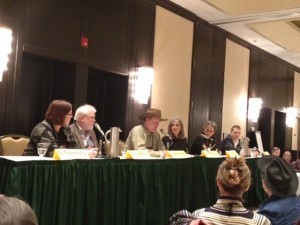
Opening panel with Sheila Connolly, Brendan DuBois, Craig Johnson, Hank Phillippi Ryan, Jennifer McMahon and Steve Ulfelder
November 7, 2014
Gonna Have Some Fun Today
Continuing our coverage of the New England Crime Bake again today. Sadly, I didn’t get photos of the dessert party–Death and Desserts–that was being set out just as I was leaving, but tomorrow all the attendees are going to hear lots of panels about the mystery business, the many ways writers approach publication, and how writers use setting, choose to write true crime, and about how we put professional sleuths and everyday people into terrifying situations.
Here is GOH Craig Johnson with our own Susan Vaughan, and introducing the premier episode of Longmire:
Of course, crime writers can’t help by photograph amusing signs, including this one:
Here’s something new and exciting we’re doing this year. Courtesy of a retired Massachusetts State Police detective lieutenant, Elaine Gill, we have a mock crime scene to examine. And here, for your delectation, are a few quick snaps of that crime scene:
Your Vicarious Weekend at the New England Crime Bake
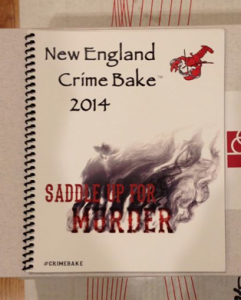 So, dear readers, we thought it would be fun to try something a little different this week. Since several of us–Barbara Ross, Vicki Doudera, Al Lamanda, Susan Vaughan, Vaughn Hardacker, and Kate Flora, are going to be at the New England Crime Bake this weekend, the region’s own mystery conference held each November in Dedham, Massachusetts, we’re going to report in from the hotel and share the conference with you.
So, dear readers, we thought it would be fun to try something a little different this week. Since several of us–Barbara Ross, Vicki Doudera, Al Lamanda, Susan Vaughan, Vaughn Hardacker, and Kate Flora, are going to be at the New England Crime Bake this weekend, the region’s own mystery conference held each November in Dedham, Massachusetts, we’re going to report in from the hotel and share the conference with you.
With luck, you’ll meet many writers, included Guest of Honor Craig Johnson, of Longmire fame, and visit the crime scene room. You can laugh at members of the committee wearing their sheriff’s badges and see a lot of cowboy, and cowgirl, boots.
We may get to take you to the chocolate party and the banquet, where you’ll see some of us trying our hand–or feet–at line dancing. And on Sunday, a bunch of writers will compose mysteries on the fly, using the conventions of their respective sub-genres.
So get ready for a weekend of vicarious fun, and a chance to see how silly writers can be when they are not at their desks hunched over their keyboards.
So here we go. Opening acts: stuffing the crime bake bags, and lunch with Craig Johnson and his wife Judy:

Lunch with Craig Johnson

Craig and Judy Johnson

Crime Bake program

Last committee lunch
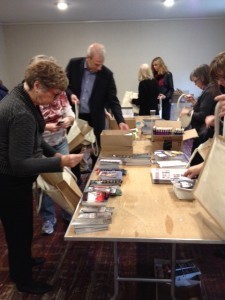
Stuffing the conference bags
November 6, 2014
In the Wake of a November Nor’easter
Sunday’s early season snowstorm may have dropped flakes as far away as South Carolina, but here in Maine – particularly along the midcoast, where I live — we felt its real wrath.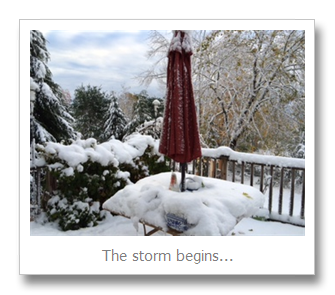
Vicki Doudera here. Fifty miles-per-hour winds and record-breaking snowfall came down all day Sunday and into the night, leaving thousands of downed trees, broken wires, and more than 140,000 homes and businesses without power on Monday.
At our house, the power flickered on and off all afternoon. We were watching the Patriots game with the woodstove fully stoked, and wondering whether we’d manage to see the whole thing. We did – but others lost power just before the game started and had to haul out old transistor radios to hear Peyton Manning’s team get trounced.
On Monday, the skies were blue and the snow had stopped, but downtown Camden was virtually shut down. Without power and with so many dangerous roads, schools and businesses could not open, and even the post office’s door was locked tight. Only Camden National Bank was open, their generator humming away and fresh, hot coffee on tap for all.
The Penobscot Bay YMCA cancelled their programs, but announced they were open with warm showers for anyone needing one. Meanwhile, Camden Hills Regional High School became an emergency warm-up shelter, and Facebook was full of people offering their woodstove-heated homes to those who lacked “back up.” By Wednesday, grocery stores large and small were forced to dispose of spoiled items from freezers and shelves.
“I feel like a pioneer woman,” said one of my friends yesterday. She’d been without power for three days but could still manage a smile. Luckily for Nancy and her husband Marlowe, the trees they lost to the storm fell away from their Colonial, but others here were not so fortunate. The town manager of Rockport narrowly escaped injury when a huge tree smashed through his roof, stopping just inches from his shoulder. He told me that just before that happened, he’d been driving home when another tree just missed his car.
Days later, we are still cleaning up the broken branches, and the snow-covered ground is littered with loose leaves. It’s heartbreaking to see so many damaged trees – not just older ones who simply couldn’t take the wind, but young specimens now uprooted due to unfrozen ground. I walked by one cemetery on Sunday and counted a dozen trees, ripped right from the ground, lying among the quiet graves.
My husband spent yesterday afternoon using his chainsaw to remove damaged limbs from a centuries-old lilac. I had to completely re-do the fence for the chicken coop, but I count myself lucky. The snow should melt by the weekend, and the leaves and limbs will eventually get removed, but the memories of this freakishly early winter storm will linger on.

November 4, 2014
Don’t Blame the Author
Kaitlyn Dunnett/Kathy Lynn Emerson here. Since several of us have new books out just now, it occurred to me that talking about some of the things that are beyond our control might be a timely topic. There’s no reason to expect readers to be savvy about the publishing business. What is out there on television and in movies often gives the wrong impression. And of course the few authors who really do become rich and famous, do get to have more of a say.
For the rest of us, there are several areas where other people make the decisions. Sometimes the results are wonderful. Other times . . . not so much.
We’ve talked about titles before. They aren’t always the ones we wanted. Enough said on that subject.
 So lets start with the cover art. Authors might be asked for suggestions, but no one in the art department has to listen to them. Sometimes no one bothers to ask for input at all. Now let me say up front that I’m pretty happy with my current cover art, but in the past there have been some real dogs. Back when I was writing historical novels for Harper Monogram, a line now defunct, I wrote a book titled Unquiet Hearts. It’s historical romance but it’s also a murder mystery involving accusations of witchcraft. The hero is the steward at a manor in Lancashire—gentry, not nobility. The heroine is in mourning and therefore is obliged to wear black. You can see how closely they paid attention to these details. I can only assume they decided she was mourning the large section of cloth missing from her gown.
So lets start with the cover art. Authors might be asked for suggestions, but no one in the art department has to listen to them. Sometimes no one bothers to ask for input at all. Now let me say up front that I’m pretty happy with my current cover art, but in the past there have been some real dogs. Back when I was writing historical novels for Harper Monogram, a line now defunct, I wrote a book titled Unquiet Hearts. It’s historical romance but it’s also a murder mystery involving accusations of witchcraft. The hero is the steward at a manor in Lancashire—gentry, not nobility. The heroine is in mourning and therefore is obliged to wear black. You can see how closely they paid attention to these details. I can only assume they decided she was mourning the large section of cloth missing from her gown.
The author has no control over what is put on the spine of the book. Especially with paperbacks, the genre is usually indicated on the spine—mystery or romance or fantasy, for example. With Unquiet Hearts the accurate description would have been “historical romantic suspense with a touch of the paranormal” but since that wouldn’t fit on the spine, they labeled it “historical romance.” Is it any surprise that readers who love that genre were less than thrilled with this novel? My “Secrets of the Tudor Court” series (written as Kate Emerson) occasionally had the same problem. All six books were historical novels—not historical mystery and not historical romance, just historical fiction. Unfortunately not everyone in the publisher’s marketing department understood the difference and they kept sending review copies to romance reviewers who, not surprisingly, didn’t care for them. Neither did readers who thought they were getting a romance novel through Goodreads or Amazon Vine.
 Sad to say, this problem cropped up in a slightly different way with my Liss MacCrimmon Mysteries. Oh, they’re labeled mysteries. No problem there. And I like my covers. But here’s the rub. The first two titles were just “A Liss MacCrimmon Mystery” but starting with the third book (A Wee Christmas Homicide) they were suddenly “A Liss MacCrimmon Scottish Mystery.” Well, okay. Liss does own and operate Moosetookalook Scottish Emporium and she was a professional Scottish dancer until a knee injury ended her career, but the series is set entirely in Maine and there are no plans to take it to Scotland. Don’t expect large doses of Liss’s Scottish-American heritage in every book, either. The marketing department couldn’t even come up with a Scottish themed title for Ho-Ho-Homicide and finally gave up trying.
Sad to say, this problem cropped up in a slightly different way with my Liss MacCrimmon Mysteries. Oh, they’re labeled mysteries. No problem there. And I like my covers. But here’s the rub. The first two titles were just “A Liss MacCrimmon Mystery” but starting with the third book (A Wee Christmas Homicide) they were suddenly “A Liss MacCrimmon Scottish Mystery.” Well, okay. Liss does own and operate Moosetookalook Scottish Emporium and she was a professional Scottish dancer until a knee injury ended her career, but the series is set entirely in Maine and there are no plans to take it to Scotland. Don’t expect large doses of Liss’s Scottish-American heritage in every book, either. The marketing department couldn’t even come up with a Scottish themed title for Ho-Ho-Homicide and finally gave up trying.
My next book, Murder in the Queen’s Wardrobe, was written with me thinking it fit into the historical cozy genre. The publisher decided to call it a “spy thriller.” Guess who will be blamed if it doesn’t meet reader expectations?
Continuing on the cover theme, what about cover copy that gives away too much of the plot? Nope—we don’t usually see that ahead of time, either. And then there’s the problem with blurbs. These are quotes, either from other writers who read the book before publication or from reviews of previous books in the series. As I discovered when I was writing my Face Down series, featuring Susanna, Lady Appleton as a sixteenth-century gentlewoman, herbalist, and sleuth, some blurbs made the mistake of calling her “Lady Susanna” instead of “Lady Appleton.” In a previous post I listed getting forms of address wrong as one of my pet peeves, so naturally I pointed this out to the powers-that-be at St. Martin’s. I was told that since the mistake was in a quote, it could not be changed. Arrrgh!
 What else is beyond the author’s control? If there’s an audio version of a book, the publisher chooses the narrator. The author only gets to listen after the book is already recorded. The publisher decides on the size of the print in a hardcover or paperback. How close to the spine the type starts, which can be a problem in paperbacks and large print editions, is also up to the publisher. Unless authors produce their own ebook editions, they aren’t given a chance to correct any of the squirrely stuff that can creep in with the different conversions required by Kindle, Nook, iBooks and so on. If the publisher of the print edition creates the ebook, we don’t see it until it is available online. Sometimes one letter shows up as another or there is a string of symbols instead of an apostrophe. Anyone who reads ebooks has come across similar oddities.
What else is beyond the author’s control? If there’s an audio version of a book, the publisher chooses the narrator. The author only gets to listen after the book is already recorded. The publisher decides on the size of the print in a hardcover or paperback. How close to the spine the type starts, which can be a problem in paperbacks and large print editions, is also up to the publisher. Unless authors produce their own ebook editions, they aren’t given a chance to correct any of the squirrely stuff that can creep in with the different conversions required by Kindle, Nook, iBooks and so on. If the publisher of the print edition creates the ebook, we don’t see it until it is available online. Sometimes one letter shows up as another or there is a string of symbols instead of an apostrophe. Anyone who reads ebooks has come across similar oddities.
We can’t forget price. The publisher definitely sets that. How much a book is discounted is up to bookseller. As far as I’m concerned, all my publishers set their prices too high, especially for ebooks. You’ll find the backlist titles I prepared myself available for under $5.00.
The only way an author can usually control any of these things, unless he or she is a bestseller with clout, is by self-publishing original material or out-of-print backlist titles. That requires paying all the costs and doing all the promotion, an expensive proposition that isn’t always feasible, especially for someone who wants to have time left over to write more books.
 There are three more things the author can’t control, even if they do self-publish. One has to do with distribution—the efficiency of bookstores in stocking titles (and packing and shipping them if they sell online). We have no good way to convince libraries, whose budgets are getting smaller and smaller, to buy copies of our books. Hint: reader requests do still carry weight.
There are three more things the author can’t control, even if they do self-publish. One has to do with distribution—the efficiency of bookstores in stocking titles (and packing and shipping them if they sell online). We have no good way to convince libraries, whose budgets are getting smaller and smaller, to buy copies of our books. Hint: reader requests do still carry weight.
And number three gets its own paragraph: what reviewers say. Heck, this could be a whole blog in itself. In a nutshell, good or awful, any review is just one person’s opinion. We can give away advance reading and author copies but we have no control over what the reader thinks of the book or what he or she says about it. And no, most writers do not “buy” good reviews or even ask their friends to give them five-star ratings. Most annoying, of course, are reviews with spoilers, followed closely by those that have nothing to do with the book itself but gripe about one of those things over which the author had no control. My favorite is a complaint about slow shipping by Amazon, followed by a one-star rating for the novel. Unless the impoverished writer is moonlighting on the Amazon assembly line, please don’t blame the author for that one!
Saving Her Life So Someday She’ll Save Yours
 Kate Flora here. This morning I have a story to tell you, one I hope may open your heart to shelters and shelter animals. First, some background. Although I was carefully watched over as a child by a brilliant collie-shepherd mix named Mrs. Kitzel who always placed herself between me and strangers, as an adult, I’ve mostly been a cat person. I’ve been dragged back into the amazing world of dogs three ways.
Kate Flora here. This morning I have a story to tell you, one I hope may open your heart to shelters and shelter animals. First, some background. Although I was carefully watched over as a child by a brilliant collie-shepherd mix named Mrs. Kitzel who always placed herself between me and strangers, as an adult, I’ve mostly been a cat person. I’ve been dragged back into the amazing world of dogs three ways.
First, by writing two true crime books–Finding Amy and Death Dealer–in which some of the heroes of the stories have been search and rescue dogs and their handlers. Second, by having my two sons and their wives adopt rescue dogs. I now have four grand dogs–Frances, Otis, Harvey, and Daisy. Finally, because I’ve spent my last two and half years helping a retired Maine game warden write his memoir, and his story is full of dogs and their amazing abilities.
I no longer look at the dogs the same way. I wonder about their backgrounds and their characteristics and what they like to do and their long lineages of interactions with humans. I’m amazed at dogs who will work for hours for the simple reward of getting to play with their toys. The stories I’ve been told are changing my landscape.

White House hero Jordan, the Secret Service K9 who stopped an intruder who jumped the fence
Like everyone else, I’ve followed the stories of secret service dogs Hurricane and Jordan stopping the man who jumped the White House fence.
Which brings me to the story of Winnie. Winnie is a Dutch Shepherd who was found wandering the streets of Atlanta, Georgia and brought to a shelter. She was mangy, flea-infested, and had worms. She was funny looking, a rangy little creature who seemed to be all ears. Active, restless, possessed of the breed’s urge to work and herd, she was not chosen by a family to be their pet.
Winnie was one day away from being put down when a young woman named Lindsey Guay, who worked with a rescue organization called The Pixel Fund http://www.thepixelfund.org saw her picture, recognized her breed, and posted her photo on Facebook, alerting her uncle, Roger Guay, and asking if he might be interested in the dog.
Knowing how valuable Dutch Shepherds can be in search and rescue, and how readily their

White House hero K9 Hurricane
characteristics can lend themselves to bomb, drug and other police and detection work, Guay said that if arrangements could be made to bring Winnie from Atlanta to Maine, he’d be glad to have her.
Winnie made the journey and arrived in Maine a sorry sight. Not a cuddly family dog–she was an energetic handful which is perhaps why someone abandoned her–but a type of dog that lives and breathes to work. A dog with a very strong herding instinct, super alert to her environment. An extremely smart animal that just wanted a job.
She was at a perfect age to start training, and after she was cured of worms and fleas and restored to health, Winnie started training as a working dog, immediately showing that she was a natural.
A few weeks ago, Roger took Winnie along to a day long dog qualifying session in Greenville, Maine. At the training, she caught the eye of Jim Roy, a deputy in the Penobscot County Sheriff’s Department. Jim Roy had a dog that was on the cusp of retirement, and was thinking of getting another dog and when he met Winnie, it was cop and Shepherd love at first sight. But there were complications. Roy was planning to retire soon himself, so the department would be
reluctant to support his acquisition of another dog. And Roy’s current dog was a great working dog but grouchy and territorial and intolerant of other dogs.
http://mainecrimewriters.com/wp-content/uploads/2014/11/WinnieVideo.mp4
Luckily for all, Roger was able to make a deal–Jim Roy would take Winnie, train her for the department’s use, and on retirement, he and Winnie would transfer their talents and services to Merrill’s Investigations and Security http://www.merrillsinvestigations.com. Best if all? Winnie’s awkward charm endeared her to Roy’s other dog, and now the two are inseparable.
This is a happy ending story. The ratty little stray from the streets of Atlanta will one day soon be either a bomb detection dog or a drug dog. Either way, because her life was saved, she may one day save yours.
November 2, 2014
But Wait, There’s More
 Hello again from Sarah Graves, writing to you from Eastport, Maine where all summer it seemed there was always more of everything, both good and not-so-good. But now it’s clear that what there isn’t more of is summer itself. The garden is a melancholy shambles, the trees are burning brightest just before the leaves go away altogether, and the sky has that hard blue light in it, now, that icy color. Most of our summer residents have flown off to their winter roosts and it really is as if a lot of birds have departed a single tree all at once, that sudden silent absence.
Hello again from Sarah Graves, writing to you from Eastport, Maine where all summer it seemed there was always more of everything, both good and not-so-good. But now it’s clear that what there isn’t more of is summer itself. The garden is a melancholy shambles, the trees are burning brightest just before the leaves go away altogether, and the sky has that hard blue light in it, now, that icy color. Most of our summer residents have flown off to their winter roosts and it really is as if a lot of birds have departed a single tree all at once, that sudden silent absence.
The light is different in another way, too, with the ever-present backlighting from the bay mixing itself into the sun’s low-angle illumination to produce a lit from all sides effect. The darkness, though, is the same, just more and more of it. Next week when daylight savings ends we will land with a (for me) hard psychological thud in Mostly Dark Most of the Time-land, and stay there until spring. I have a plan for dealing with the darkness, though: did you know that light reflected up off the pages of a book is just like summer sunlight?
itself into the sun’s low-angle illumination to produce a lit from all sides effect. The darkness, though, is the same, just more and more of it. Next week when daylight savings ends we will land with a (for me) hard psychological thud in Mostly Dark Most of the Time-land, and stay there until spring. I have a plan for dealing with the darkness, though: did you know that light reflected up off the pages of a book is just like summer sunlight?
 My new neighbor across the street has begun the task of rehabilitating this old beauty. But the pillars are being stubborn. These strips of old paint look as if they’d fall if you just blew on them, but they’re actually sort of melded with the wood after all this time. So far they have resisted power sanding and power washing. A hammer and chisel might do it, or a heat gun. I have never used a heat gun because our house is so old and dry you could light it with a match; also, lead paint plus heat gun equals poisonous fumes (I like these in literature but not in life). Outdoors, though, I might risk it, keeping a hose handy. Or — well, no, I probably wouldn’t, because if I did the I’d have to sit up all night making sure the fire didn’t smolder for hours before finally showing itself around 2 AM, as they do.
My new neighbor across the street has begun the task of rehabilitating this old beauty. But the pillars are being stubborn. These strips of old paint look as if they’d fall if you just blew on them, but they’re actually sort of melded with the wood after all this time. So far they have resisted power sanding and power washing. A hammer and chisel might do it, or a heat gun. I have never used a heat gun because our house is so old and dry you could light it with a match; also, lead paint plus heat gun equals poisonous fumes (I like these in literature but not in life). Outdoors, though, I might risk it, keeping a hose handy. Or — well, no, I probably wouldn’t, because if I did the I’d have to sit up all night making sure the fire didn’t smolder for hours before finally showing itself around 2 AM, as they do.
 I finished a book last week. Writing one, I mean. And as always, the main thing I feel is relief. As I mentioned, there were quite a lot of events going on here this summer; luckily, though, my most prominent character trait is bone-headed stubbornness. So the thing is done and on someone else’s desk for a few days, and after that there’ll be another whole wild thicket of stuff to confront. But at the moment I have a little time to read, plus some actual unoccupied brain cells to do it with. Result: I was the only person in the world who hadn’t read GONE GIRL, but now I have, and I am the still only person who hasn’t written all about what they think of it, and I’m not going to. But isn’t it interesting how huge it is in pop culture right now? When not long ago we were talking about whether or not characters in novels should be “likable.”
I finished a book last week. Writing one, I mean. And as always, the main thing I feel is relief. As I mentioned, there were quite a lot of events going on here this summer; luckily, though, my most prominent character trait is bone-headed stubbornness. So the thing is done and on someone else’s desk for a few days, and after that there’ll be another whole wild thicket of stuff to confront. But at the moment I have a little time to read, plus some actual unoccupied brain cells to do it with. Result: I was the only person in the world who hadn’t read GONE GIRL, but now I have, and I am the still only person who hasn’t written all about what they think of it, and I’m not going to. But isn’t it interesting how huge it is in pop culture right now? When not long ago we were talking about whether or not characters in novels should be “likable.”
This is the first in the new series I’m writing. Due out at the end of this coming December, WINTER AT THE DOOR stars ex-Boston murder cop Lizzie Snow, who’s about to discover that remote rural Maine has a dark side. No surprise to anyone who lives there, I’m sure — when you get that far off the beaten track, and the population pressure is that low, people tend to let their psychologies bloom, for good or ill. Even here in Eastport, not so far off the beaten track anymore, we tend to allow our quirks off their leashes and tolerate one another’s picturesque habits — in costume, for instance, or in social graces or the lack of them. Or whatever. Anyway, Lizzie has her own dark side to contend with — and what she doesn’t know is that from the moment she arrives in Maine, someone’s watching her do it.
Lea Wait's Blog
- Lea Wait's profile
- 509 followers




